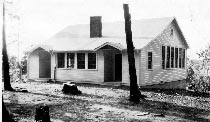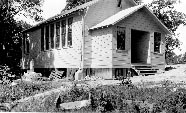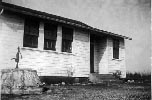Schools in Montgomery County
Tennessee
School Histories
Building Rosenwald Schools
In 1834 teaching slaves to read and write was illegal. In North
Carolina a free slave was given thirty-nine lashes if caught teaching a
slave to read. A white person was fined $200. In Georgia a
white person was fined $500 and imprisoned if caught. In Louisiana
teaching a slave to read was punishable by one year in prison. As
a result, when the civil war ended, the slaves had little or no education.
The Constitution guaranteed a free public education, but in the early
1900’s the whites still felt there was no need to educate the black people.
So the black children attended schools held in churches, barns and buildings
no better than a shack. Their teachers were not as educated as the
white teachers and their school year was shorter. Most of the students
were children of tenant farmers. They attended school between planting
and harvesting of the crops. Because of lack of attendance, many
of these children never got out of the first grade. This has been
shown may times in the school records of 1922 for Montgomery County.
There are instances when a student stayed in the first grade for five years
and then quit.
In 1912 a man named Julius Rosenwald a friend of Booker T. Washington,
saw the plight of the African Americans and set about to make changes.
Julius Rosenwald, an American Jew also lacked an education. His wealth
came from his position as President and later Chairman of the Board of
Sears Roebuck and Company. When most philanthropists feared
incurring the wrath of the white population if they helped the African
Americans, Julius Rosenwald did not care.
Julius Rosenwald set up the Rosenwald Fund, which helped build over
5,000 African American rural schools in fifteen states in the South. These
states included: Alabama, Arkansas, Florida, Georgia, Kentucky Louisiana,
Maryland, Mississippi, Missouri, North Carolina, South Carolina, Tennessee,
Texas, Virginia and West Virginia.
In order to qualify for Rosenwald money a school was required to add
matching funds either in cash or other contributions such as land, lumber
or labor. Local governments also contributed money for building the
schools. For instance in the Board Minutes dated 16 September 1922
for the Montgomery County School System, Warfield School in District one
and Rives School in District four were built with Rosenwald funds. The
state provided $1,000, and the Rosenwald Fund provided $1,400.
Material for these schools cost $2,435 for each school, painting the
buildings cost $130.00 and carpentry work was $863.00. The actual
cost to the school board was figured to be around $1,600. An additional
amount of twelve dollars each was given by the superintendent for outhouses
and five dollars was given to paint them. This was a luxury when
most toilet needs were preformed behind a bush as noted in the 1940-1941
Tennessee School Register of Rocky Hill School.
 Pisgah
(pronounced Piskey by students) also raised money for a Rosenwald School.
In the Montgomery County board minutes dated 08 September 1927, the Pisgah
patrons agreed to raise $250 and haul all the material to build the school.
Since the patrons were busy with their crops, they hired J.W. Hayes of
the Clarksville Transfer Company to do the hauling. Unable to pay
$250 as agreed, the Executive Committee accepted a temporary note
from the patrons for $170 with the remainder due in six months. Two
acres of land was donated by Mr. Jobe and deeded to the Montgomery County
Board of Education for the building site. The Rosenwald Fund provided
$500. The Superintendent reported that he figured the actual cost
of Pisgah School to the taxpayers of Montgomery County to be about $600.
Pisgah
(pronounced Piskey by students) also raised money for a Rosenwald School.
In the Montgomery County board minutes dated 08 September 1927, the Pisgah
patrons agreed to raise $250 and haul all the material to build the school.
Since the patrons were busy with their crops, they hired J.W. Hayes of
the Clarksville Transfer Company to do the hauling. Unable to pay
$250 as agreed, the Executive Committee accepted a temporary note
from the patrons for $170 with the remainder due in six months. Two
acres of land was donated by Mr. Jobe and deeded to the Montgomery County
Board of Education for the building site. The Rosenwald Fund provided
$500. The Superintendent reported that he figured the actual cost
of Pisgah School to the taxpayers of Montgomery County to be about $600.
Julius Rosenwald died in 1932. When the Rosenwald fund was established
it had a strict time limit. Rosenwald imposed these condition:
the fund was to run no more than 25 years after his death, and all the
money was to be spent. As part of the requirements, schools were
also required to teach some type of vocational class such as sewing, gardening
or shop. Rocky Hill was such a school. During the 1940–1941
school year, the school bought twenty-one chicks for the students to raise.
Thirteen of the chickens lived. Two pigs were also bought for $2.50. The
students sold them at the end of the year for $15.00. A garden was put
in, and the students agreed to take care of it in the summer.
The calendar for colored schools of Montgomery County during the 1931-1932
school year included a school improvement program. The program stressed:
Why boys and girls should stay on the farm, more real work in Home Economics,
teaching pupils how to economize in all phases of home making and also
stated that poultry raising and gardening must not be overlooked.
Quarles School in district three and Glenellen School in district two
also received Rosenwald funds. In the Board Minutes dated 13 July
1930, the work was completed on Quarles and Glenellen schools, inspected
by the State Department and $150 was received from the Rosenwald Fund for
Quarles and $200 was received for Glenellen. Glenellen patrons  had
already raised $200 in August of 1928 to build a new school and agreed
to improve the grounds, dig a cistern and do the plastering. The
county
had
already raised $200 in August of 1928 to build a new school and agreed
to improve the grounds, dig a cistern and do the plastering. The
county  agreed
to furnish the cement, pump and gutters for the new school.
The patrons from Quarles School had raised $100 in April for their new
addition. The total cost for the addition was $565.
agreed
to furnish the cement, pump and gutters for the new school.
The patrons from Quarles School had raised $100 in April for their new
addition. The total cost for the addition was $565.
Needmore Colored School, Rosenwald School and New Providence Colored
School also received Rosenwald Funds. The plans for Rosenwald Schools
were so successful the county began to build white schools with the same
plans. Unfortunately consolidation was the end for Rosenwald Schools.
On 06 August 1928 the Superintendent read a letter from the State Department
stating that the Consolidation Fund could not be used where the State Rural
(Rosenwald) Fund is being used. The building of Rosenwald Schools
had met its death. Rosenwald Schools were left behind to deteriorate and
stand empty. Today Rosenwald Schools are listed on America's 11 Most
Endangered Historic Places. This marks the end of an era.
Written by Sandra Stacey
 Pisgah
(pronounced Piskey by students) also raised money for a Rosenwald School.
In the Montgomery County board minutes dated 08 September 1927, the Pisgah
patrons agreed to raise $250 and haul all the material to build the school.
Since the patrons were busy with their crops, they hired J.W. Hayes of
the Clarksville Transfer Company to do the hauling. Unable to pay
$250 as agreed, the Executive Committee accepted a temporary note
from the patrons for $170 with the remainder due in six months. Two
acres of land was donated by Mr. Jobe and deeded to the Montgomery County
Board of Education for the building site. The Rosenwald Fund provided
$500. The Superintendent reported that he figured the actual cost
of Pisgah School to the taxpayers of Montgomery County to be about $600.
Pisgah
(pronounced Piskey by students) also raised money for a Rosenwald School.
In the Montgomery County board minutes dated 08 September 1927, the Pisgah
patrons agreed to raise $250 and haul all the material to build the school.
Since the patrons were busy with their crops, they hired J.W. Hayes of
the Clarksville Transfer Company to do the hauling. Unable to pay
$250 as agreed, the Executive Committee accepted a temporary note
from the patrons for $170 with the remainder due in six months. Two
acres of land was donated by Mr. Jobe and deeded to the Montgomery County
Board of Education for the building site. The Rosenwald Fund provided
$500. The Superintendent reported that he figured the actual cost
of Pisgah School to the taxpayers of Montgomery County to be about $600. had
already raised $200 in August of 1928 to build a new school and agreed
to improve the grounds, dig a cistern and do the plastering. The
county
had
already raised $200 in August of 1928 to build a new school and agreed
to improve the grounds, dig a cistern and do the plastering. The
county  agreed
to furnish the cement, pump and gutters for the new school.
The patrons from Quarles School had raised $100 in April for their new
addition. The total cost for the addition was $565.
agreed
to furnish the cement, pump and gutters for the new school.
The patrons from Quarles School had raised $100 in April for their new
addition. The total cost for the addition was $565.